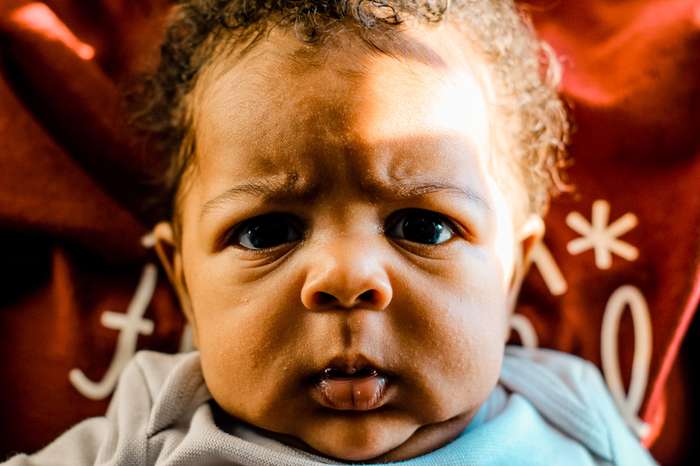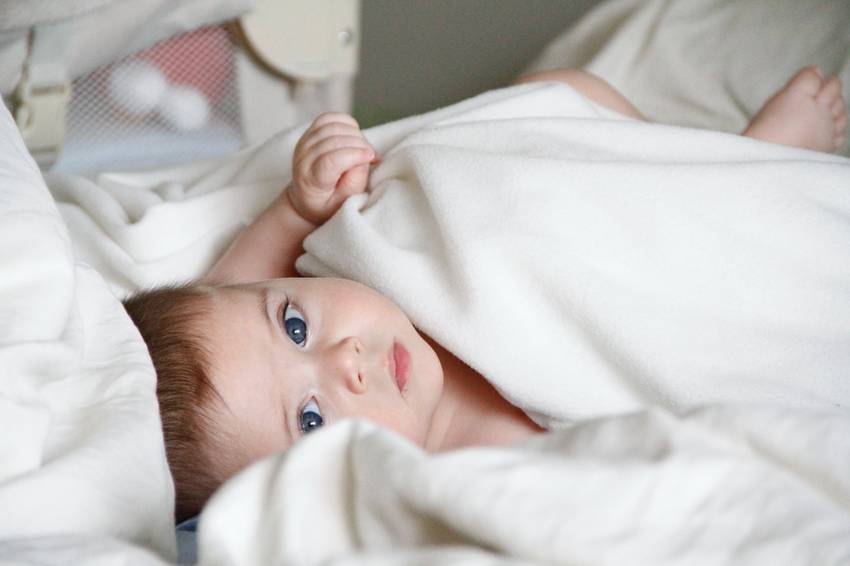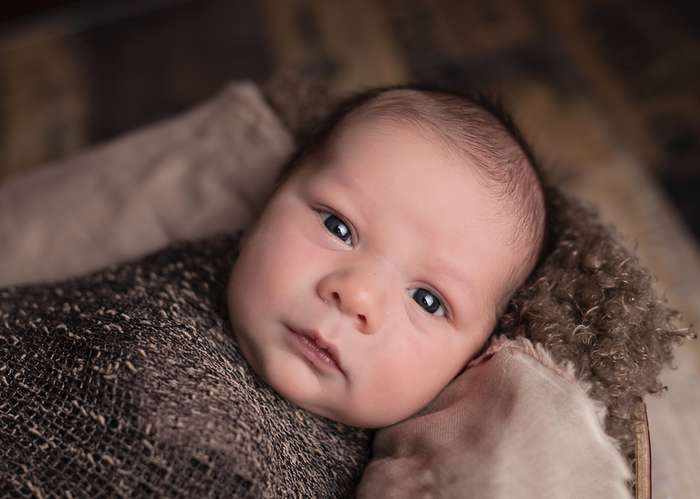It’s normal to notice small facial features on your little one after they’re born, but became concerned when your baby has a recessed chin can lead to worry and questions. But don’t worry; with proper care and timely attention, there are ways that you can help your infant grow into their normal appearance.
So, Do Babies Grow Out of Recessed Chin?
Yes, most infants with a slightly recessed jaw tend to outgrow feeding concerns as they grow older. At around 3 – 4 months of age, During this time of rapid face development, the jaw advances, the pharynx deepens, and the neck lengthens. This developmental process often resolves mild to moderate cases of a recessed chin.
In this blog post, we will be exploring some of these methods as well as answering the question of when do babies lose recessed chin.

Do Babies Grow Out of Recessed Chin?
In most cases, a recessed chin is nothing to worry about, and your child will grow out of it.
The good news is that if you detect a concave look in your child’s jaw, he or she will most likely outgrow it.
However, if you’re worried about it and have tried everything else with no luck, see your doctor. They might be able to determine whether they have a condition in which their bottom lip folds in.
Tucked Bottom Lip Of Baby
If your baby’s jaw is depressed, it may be difficult to feed them. It’s difficult to suck and swallow when the nipple and areola compress. You may have even attempted a breast shield, or removing your baby from one might be challenging. It comes as no surprise that tongue-tie is so frequently mistaken in newborns.
Changing your posture to a more leisurely one, on the other hand, allows gravity to assist you. Because gravity draws the tongue and jaw forward, the baby can feed effectively, allowing you to free yourself of the responsibility.
The lower lip flip for feeding is a technique that you can use until your doctor determines whether or not your baby has a recessed jaw. When your infant is being nursed appropriately, his or her mouth should open wide and have a fish mouth. The lips in this situation are flanged outward. Your breasts may cover your lower lip in this posture.
What Is A Recessed Chin Baby?
Micrognathia, sometimes known as mandibular hypoplasia, might prevent your kid from getting enough to eat or breathe.
Between breastfeeding and formula feeding, a narrow latch occurs when the infant attempts to balance out the nipple’s anterior rotation between the upper and lower gum lines.
A recessed chin can also cause problems with speech. The tongue may not be able to move freely, which can make it difficult to produce certain sounds.
It can be frightening, and it’s connected to some much more serious concerns. The average age of a baby who has this problem is between ten and twelve weeks. While several factors may contribute to a newborn’s receding chin, the jaw generally completes development near the very end of pregnancy.
What causes a recessed chin?
Before we dive into the causes of a receding chin in a baby, it’s important to understand what a receding chin is. A receding chin is when the chin appears to be smaller or less prominent than it should be.
In some cases, a receding chin may be barely noticeable, while in other cases, it can be more pronounced. Main causes of recessed chin newborn are mentioned below.

Genetic Factors
One of the reasons for a receding chin in a baby is genetics. A receding chin may be an inherited trait that runs in the family. If one or both parents have a receding chin, there is a chance that their baby may also have a receding chin.
Abnormal Jaw Development
Another cause of a receding chin in a baby is abnormal jaw development. This can happen due to a variety of reasons, including:
Prenatal factors
Exposure to certain substances during pregnancy, such as alcohol or drugs, can affect the baby’s jaw development.
Birth trauma
Trauma during birth can also cause abnormalities in jaw development.
Genetic Syndromes
Certain genetic syndromes, such as Treacher Collins syndrome and Pierre Robin sequence, can cause a receding chin.
Medical Conditions
There are several medical conditions that can cause a receding chin in a baby, including:
Hypotonia
Hypotonia is a condition where the baby has low muscle tone, which can affect the development of the jaw muscles.
Cerebral palsy
It is a group of neurological disorders that can cause physical disabilities in the body including weak muscles and coordination problems. This can result in a variety of facial deformities such as a recessed chin.
Positional Plagiocephaly
When a newborn is placed in the same posture for long periods of time, he or she may develop a disorder called positional plagiocephaly, This can lead to a receding chin as the flattened area of the head can push the chin back.
How To Get A Newborn’s Recessed Chin Diagnosed?
As new parents, you must be thinking do babies grow out of recessed chins? But in most cases, you don’t need to worry about this condition as it resolves on its own as the child grows.
Typically, a newborn retracted chin causes the lower jaw to be positioned further back than the upper jaw. Babies with recessed chins often have trouble breathing and latching.
As a result, using a bottle or nipple shield may help you out considerably.
How To Feed A Baby With A Recessed Chin?
Use nipple shields if you don’t want your baby to get picky with the shields you’re using. To know whether your baby is receiving milk, check for milk in your nipple shield.
To keep your newborn fed while being protected, have your lactation consultant weigh them before and after nursing. Prepare to stay closely linked with a comfy chair and a decent breast pump.
You may even want to consider co-sleeping so you can keep an eye on your little ones and prevent them from rolling away. A baby with a recessed chin often has trouble latching, which makes it difficult for them to eat. As a result, you may need to use a nipple shield or bottle to feed your baby.
Recessed Chin vs Normal Baby Chin?
A recessed chin is a condition where the jaw appears to be set back farther than normal. This results in the chin appearing sunken, creating a concave appearance on the lower part of the face. A normal baby chin typically has more of a rounder look, with the jaw not appearing to be set back as far as it does in a recessed chin.
Is There A Treatment For Recessed Chin?
Most babies with a recessed chin do not require treatment. The condition usually corrects itself as the baby grows older and the jawbone develops.
A recessed chin can also be caused by other medical conditions, such as cleft palate or Pierre Robin syndrome. If your child has one of these conditions, he or she will likely need other treatments in addition to surgery for the recessed chin.
Pierre Robin syndrome is a condition that affects the development of the jawbone and face. It also affects the child’s speech development. Surgery is usually necessary to repair it.
Overcoming Micrognathism with Exercises
You may also want to try some exercises. You can do this by placing your baby on their back and then gently moving their chin from side to side and up and down. This helps loosen the muscles in the lower jaw, neck, and face. It also promotes movement in the upper jaw.
What is the answer – Chin Surgery or Implant?
Chin Implants
Chin implants, also known as alloplastic genioplasty, involve inserting silicone or other synthetic material into the chin to enhance its size and projection. This is a 30-45 minute treatment performed under local anesthesia. Most people can go back to work or school in a week or two after surgery.
Horizontal sliding genioplasty
To enhance the prominence of the jawline, some elect to have a surgical treatment called horizontal sliding genioplasty. This is a more involved procedure than chin implants and requires general anesthesia. Recovery time may be longer, with some patients needing several weeks to recover fully.
Jaw surgery
Recessed chins may be fixed with jaw surgery, often called orthognathic surgery. This is a more extensive procedure than chin implants or sliding genioplasty and is typically reserved for cases where there is a significant discrepancy between the upper and lower jaws.
It is important to note that while these procedures can improve the appearance of a recessed chin, they come with risks and potential complications. It is essential to consult with a qualified plastic surgeon or oral and maxillofacial surgeon to determine if chin surgery or implants are appropriate for your individual case.

Frequently Asked Questions
Q1: Is it possible to be handsome while having a weak chin?
Ans: This can contribute to a more feminine look in males. It might make a woman’s nose seem fat and broad. A weak chin detracts from the face’s natural and appealing proportions in both men and women.
Q2: When you get older, do your chins get bigger?
Ans: Once you’ve stopped developing, your chin will eventually stop growing. Occasionally, there are cases of head deformation as a result of chin growth, and if it occurs, it might be a consequence of an underlying medical problem.
Q3: Do you breathe through your mouth if you have a weak chin?
Ans: Yes. It also creates an unattractive face profile that leads to self-esteem issues in youngsters.
Q4: Why are babies’ chins recessed?
Ans: You may notice that your baby has a recessed chin, which is simply nature’s way of assisting him in breastfeeding.
Q5: When does the baby’s recessed chin go away?
Ans: The good news is that, in most situations, these feeding difficulties go away as the baby’s jaw recedes.
Q6. Do newborns outgrow recessed chin?
Ans: Newborns may not outgrow a recessed chin, as the chin’s growth is largely determined by genetics. However, some mild cases may improve as the child grows and their facial bones develop.
Q7. When does a baby’s chin develop?
Ans: A baby’s chin begins to develop during the first trimester of pregnancy. By the end of the second trimester, the chin and lower jaw have formed, although they continue to grow and develop throughout childhood and adolescence.
Conclusion
A recessed chin is a common condition among newborns, but it usually corrects itself as the baby grows. While a weak chin might not be the most attractive facial feature, it’s nothing to worry about.
In most circumstances, it’s simply a question of waiting for your kid to mature. And in the meanwhile, there are several strategies to work around it. If you’re concerned about how your infant looks, see your doctor. They may put your mind at rest while also informing you what to anticipate as your kid grows.







